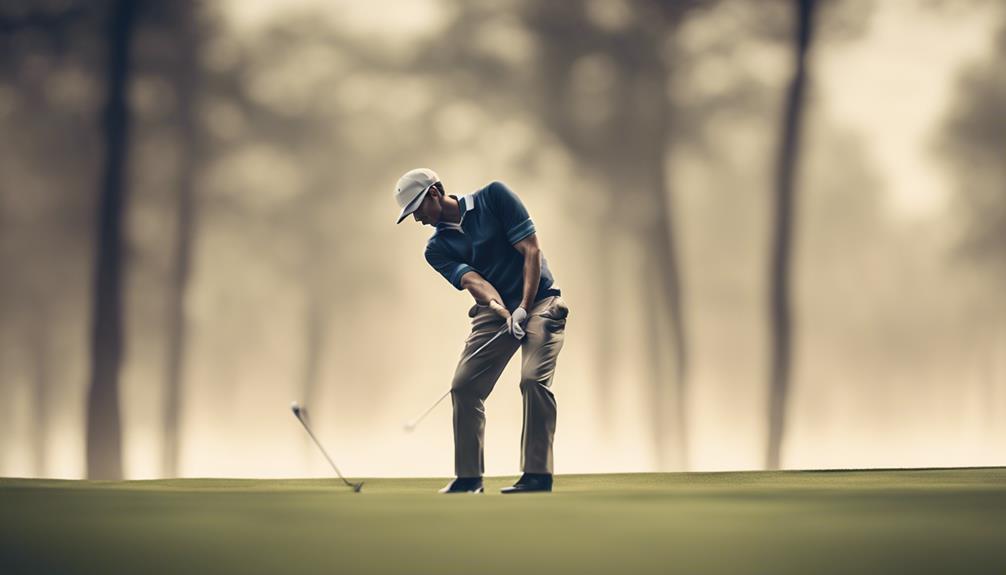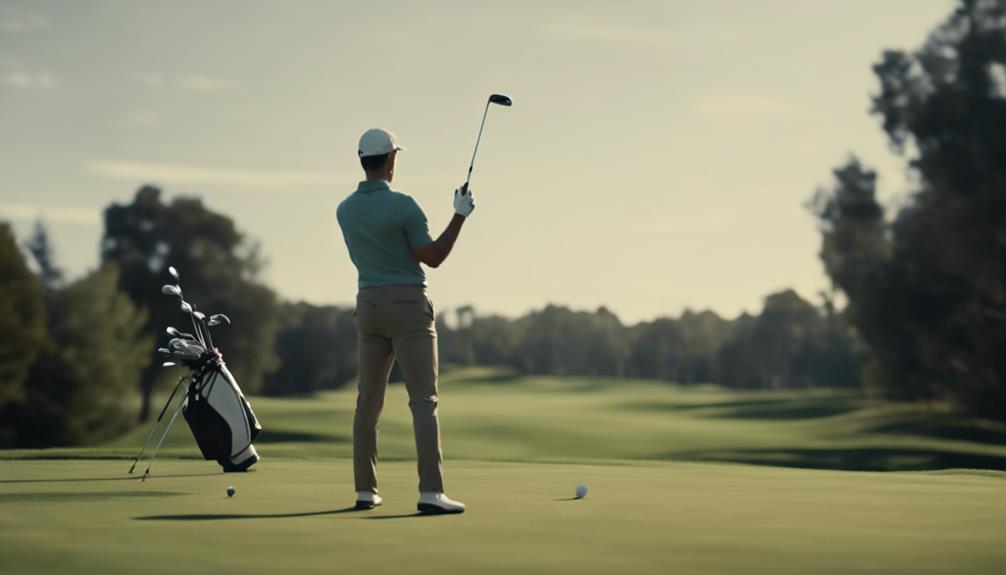- 7 Top Flite Golf Clubs XL for Improved Performance - September 28, 2024
- Top Flite Golf Clubs: Top 5 Reasons to Choose Them - September 28, 2024
- Top 3 Golf Club Fitters for a Perfect Swing - September 28, 2024
To choose the right golf club length chart in 7 simple steps, start by determining your wrist-to-floor measurement, which typically corresponds to a standard club length between 32 and 34 inches. Next, refer to a sizing chart that factors in wrist size, swing style, and club fitting guide to guarantee a correct fit. Consider your swing style, posture, and arm length, as they affect your ideal club length. Get a static or dynamic fitting to evaluate your swing motion and ball flight patterns. Consult a professional fitter to pinpoint the ideal club length, weight, and lie angle. Finally, finalize your club selection based on your swing style, posture, and grip size. By following these steps, you'll be well on your way to finding the perfect fit – and optimizing your game.
Key Takeaways
- Measure overall height and wrist-to-floor distance to determine correct club length, with standard length corresponding to 32-34 inches.
- Refer to a sizing chart that considers wrist size, swing style, and club fitting guide to ensure correct fit.
- Consider swing style, posture, and tempo to adjust club length, with slower swing speeds requiring shorter shafts and faster swing speeds requiring longer shafts.
- Evaluate arm length and lie angle to ensure proper fit, with upright swing planes benefiting from more upright lie angles and slanted swing planes requiring flatter lie angles.
- Consult a professional club fitter to pinpoint ideal club length, weight, and lie angle by analyzing unique physical characteristics and swing dynamics.
Determine Your Measurements
To accurately determine the correct golf club length, start by taking two key measurements: your overall height in inches and your wrist-to-floor measurement.
Your height is the primary factor in determining the correct club length, so make sure to get an accurate reading.
Next, take your wrist-to-floor measurement by standing on a hard floor with your arms hanging straight down at your sides, and measure the distance from the floor to the crease in your wrist in inches.
This measurement will help you determine if you need a standard club length or something longer or shorter.
Keep in mind that a wrist-to-floor measurement between 32 and 34 inches corresponds to a standard club length.
Additionally, consider your arm length and posture, as these can also affect the ideal club length for your swing style.
Refer to a Sizing Chart
Now that you've taken your measurements, it's time to refer to a sizing chart to determine the correct club length for your game.
You'll want to factor in such aspects as your wrist size, swing style, and club fitting guide to guarantee you're getting the right fit.
Measure Your Wrist Size
When determining your ideal golf club length, start by measuring your wrist size, a key factor that greatly impacts your stance and swing posture.
To do this, stand with your feet together, wearing street shoes or sneakers, and let your arms hang straight down at your sides. Then, measure the distance from the floor to the crease in your wrist – this is your wrist-to-floor measurement. Take note of this static measurement, as it will help you determine the correct club length for your golf club size and grip size.
Measure your wrist size accurately using a yardstick or tape measure, and record the measurement in inches.
If your wrist-to-floor measurement is 33 inches or less, you'll likely need shorter golf clubs. Conversely, if your measurement is 34 inches or more, standard or longer clubs will be more suitable.
Refer to a sizing chart to determine the proper length of your golf clubs based on your wrist size and height. By doing so, you'll guarantee a comfortable and effective swing, allowing you to master the game.
Consider Your Swing Style
Your swing style also plays a critical role in determining the ideal golf club length, as it directly affects your posture, balance, and overall swing mechanics.
A club fitter will take into account your swing style during the custom fitting process to guarantee the club suits you perfectly.
If you have a slower swing speed, you may require a shorter shaft with a softer flex to generate more power and control.
If you have a faster swing speed, you may require a longer shaft with a stiffer flex to maintain stability and accuracy.
Players with a more upright swing plane may benefit from a shorter club length to prevent the club from digging into the ground.
Those with a more horizontal swing plane may require a longer club length to maintain a consistent strike.
During the dynamic fitting process, your club fitter will analyze your swing style and players' height to determine the ideal club length for you.
Check Club Fitting Guide
Referencing a club fitting guide or sizing chart is a crucial step in determining the ideal golf club length, as it provides a standardized measurement based on your unique physical characteristics.
By considering your height, wrist-to-floor measurement, and arm length, these charts can help you find the correct length for your clubs.
Standard length charts are available for men and women, with adjustments made for taller or shorter golfers. For example, you may need to add or subtract half an inch for every 6 inches of height difference.
The type of club also plays a role, with drivers typically being longer than irons and wedges. Some charts provide a range of lengths for each club, allowing you to choose the best fit based on your individual swing style and preferences.
To confirm accuracy, consult a professional club fitter or use a reliable online fitting tool. By following the guide, you'll be able to find the perfect length and lie for your clubs, allowing you to optimize your golfers' ability and improve your overall game.
Consider Your Swing Style

When evaluating your swing style, you'll want to examine three key aspects: your aggressive or conservative approach, your fast or slow tempo, and your upright or slanted plane.
These factors will impact how you interact with your clubs, and ultimately, the length that's right for you.
Aggressive Vs Conservative
As you step up to the tee, your swing style is a crucial determinant of the ideal club length, and understanding whether you're an aggressive or conservative golfer can make all the difference in your game.
Your swing style affects the clubhead speed, ball flight, and overall performance, making it a critical factor in club length selection.
Aggressive golfers with faster swing speeds may benefit from shorter clubs to reduce the likelihood of hitting the ball too far off-target, while conservative golfers with slower swing speeds may prefer longer clubs to maximize distance.
Aggressive golfers tend to have a more vertical swing plane, resulting in a higher ball flight and a greater risk of slicing or hooking, whereas conservative golfers typically have a more horizontal swing plane, resulting in a lower ball flight and more controlled shots.
When choosing a club length, aggressive golfers may prefer a club length that's 0.5 to 1 inch shorter than standard, while conservative golfers may prefer a club length that's 0.5 to 1 inch longer than standard.
Understanding your swing style will help you determine the ideal club length for your game, ensuring you're playing with the right tools to achieve mastery.
Fast Vs Slow Tempo
Your swing tempo, whether it's fast and explosive or slow and deliberate, has a profound impact on your clubhead speed and overall performance, making it a vital factor to weigh when selecting the ideal club length.
A fast swing tempo typically generates more speed, but may require a shorter shaft length to maintain control. Conversely, a slow and deliberate tempo might benefit from a longer shaft to maximize distance.
When determining the right length for your golf clubs, consider your swing style. If you have a fast tempo, you may need to adjust the length to prevent the clubhead from closing too quickly.
This might mean opting for a shorter club, which will help you maintain a consistent swing plane. On the other hand, if you have a slow tempo, a longer shaft might be more suitable, allowing you to generate more power and distance.
Remember, the average driver length is around 45 inches, but you may need to deviate from this standard to find the best length for your unique swing.
Upright Vs Slanted Plane
Your swing plane, whether it's upright or slanted, also plays a significant role in determining the ideal club length, as it affects the angle of attack and how the clubhead approaches the ball.
If you have an upright swing plane, you'll benefit from a more upright lie angle, which allows your arms to hang straight down from your shoulders. This results in a more vertical angle of attack, making it easier to hit the ball with a higher trajectory.
On the other hand, if you have a slanted swing plane, you'll need a flatter lie angle to accommodate your swing. This will help you achieve a more shallow angle of attack, resulting in a lower trajectory.
- Upright swing plane: more upright lie angle, higher trajectory
- Slanted swing plane: flatter lie angle, lower trajectory
- Note your swing plane when choosing club types, especially with your driver length
- Experiment with different lie angles to find the perfect fit for your unique swing style
Get a Static Fitting
To determine the correct club length, a static fitting measures your height, wrist-to-floor measurement, and arm length, providing a cost-effective estimate that, while not as precise as dynamic fitting, can still give you a good starting point.
This method is simple and quick, making it ideal for golfers new to the game or those seeking a rough estimate of their club length.
During a static fitting, you'll typically use a chart or formula to determine the correct club length based on your measurements.
Club manufacturers often provide standard clubs designed for golfers of average height, but a static fitting can help you determine if you need a shorter or longer club.
Keep in mind that a static fitting doesn't take into account your posture, swing style, or other physical characteristics that can affect the accuracy of the fitting.
However, it can still provide a useful estimate, and you can always opt for a more precise dynamic fitting later.
Opt for a Dynamic Fitting

When seeking a more precise club length determination, opt for a dynamic fitting, which involves evaluating your swing motion to determine the correct club length.
This process provides a more accurate assessment than static fitting, as it considers your unique swing characteristics and ball flight patterns.
During a dynamic fitting session, the fitter will observe your stance, posture, and swing motion to identify any issues that may affect shaft length assessment.
This thorough approach guarantees you get the correct golf club that suits your game.
It considers your launch angle and swing speed to provide a more accurate club length assessment.
It helps identify stance-related issues or movements that affect shaft length assessment.
Trimming from the grip end of the shaft minimizes the impact on flex, while trimming from the tip end increases stiffness.
Results are generally more accurate than those from static fitting, leading to a better club length determination.
Consult a Professional Fitter
They can help you pinpoint the ideal club length, weight, and lie angle by analyzing your unique physical characteristics and swing dynamics.
As a golfer, you need help determining the right fit for your game, and that's where a professional club fitter comes in.
During a thorough fitting session, they'll evaluate your swing motion, ball flight, and impact contact to determine the correct club length and other specifications.
They'll also take into account your overall height, wrist-to-floor measurement, and posture to make sure you're getting the right golf clubs for your unique needs.
A professional club fitter can identify any compensations or adjustments you may be making in your swing due to ill-fitting clubs and provide recommendations for adjustments to improve your overall game.
By consulting a professional fitter, you can verify that your clubs are tailored to your specifications, leading to improved performance, consistency, and overall enjoyment of the game.
Don't settle for anything less – make sure you're getting the best fit for your game by consulting a professional club fitter for length and other specifications.
Finalize Your Club Selection

Now that you've consulted a professional fitter to determine your ideal club length, weight, and lie angle, it's time to finalize your club selection by thinking about various factors that will further optimize your game.
With your right club length in mind, you'll want to reflect on your swing style, posture, and grip size to verify the club feels comfortable and natural in your hands.
Swing style: Do you have a slow and controlled swing or a fast and aggressive one? This will impact the club's weight and flexibility.
Posture: Do you stand upright or have a more bent posture? This will affect the club's lie angle and how it interacts with the ground.
Grip size: Have you been fitted for the correct grip size to guarantee a comfortable and secure hold?
Fitting type: Did you opt for a static fitting, using your wrist-to-floor measurement, or a dynamic fitting, which examines your ball speed and spin rate?
Frequently Asked Questions
How to Choose Golf Club Length?
When choosing a golf club length, you'll need to take into account your golf swing, body type, and posture style, as well as your arm length, hand size, wrist angle, and grip size, while also factoring in personal preference and club fitting.
What Size Golf Clubs for a 6 Foot Man?
As a 6-foot man, you'll benefit from considering height advantages, body type, swing style, and age factor when selecting clubs; also, think about club material, grip size, shaft flexibility, posture impact, and hand size to find the perfect fit.
What Is the Best Way to Figure Out Golf Distances?
You determine golf distances by combining data from Golf Rangefinders, tracking Swing Speed, analyzing Ball Flight, and noting Yardage Markers, while considering Course Slope, Pin Position, and Carry Distance, with Measured Swings and GPS Watches providing additional accuracy.
How to Tell if Golf Clubs Are Too Short?
As you grip the club, do you feel cramped or stretched? You'll know your clubs are too short if your proper stance is compromised, and your unique swing style, body type, arm length, wrist size, forearm size, posture issues, and hand size aren't synced.
Conclusion
As you stand confidently on the course, your clubs feeling like an extension of your body, remember that finding the perfect fit was like discovering a hidden pathway to a world of precision and power.
The right club length chart was your guide, and now every swing is a harmonious blend of strength and finesse.
With each shot, you're not just playing golf – you're conducting a symphony of motion, with every club singing in perfect harmony.




